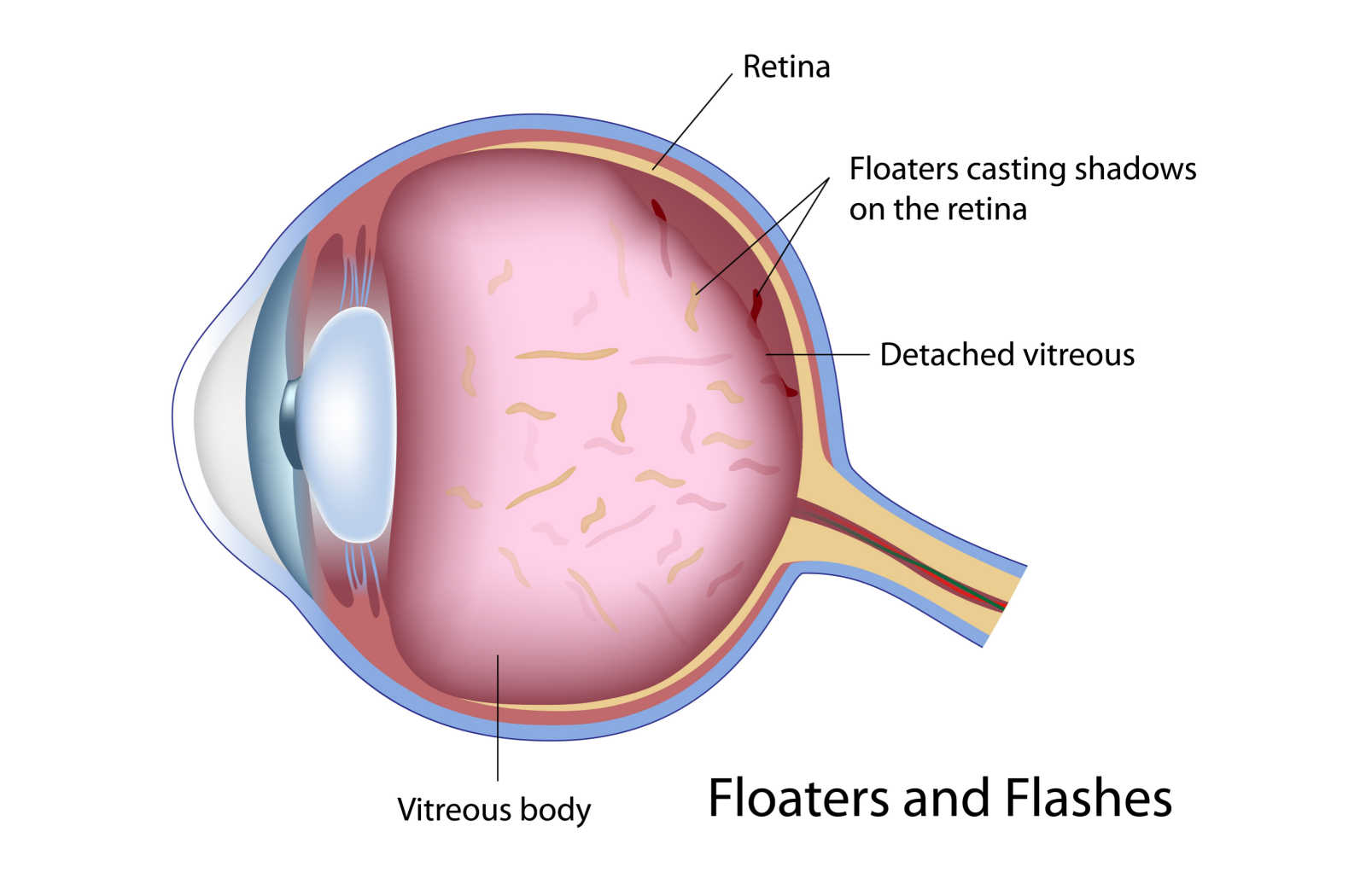Millions of Canadians are dealing with the uncomfortable symptoms of dry eye disease. Unfortunately, dry eyes often accompany other uncomfortable conditions like digital eye strain or floaters, so it’s not unreasonable to wonder if dry eyes will cause floaters or vitreous detachment.
While vitreous detachment and dry eye symptoms are both often related to aging, there isn’t any further connection between them—dry eye does not cause vitreous detachment.
Generally, both conditions can be comfortably managed, and treatment is available. If dry eyes or vitreous detachment are affecting your comfort or vision, your eye doctor can discuss your treatment options and help you work toward relief.
What Is Vitreous Detachment?
Our eyes are filled with a gel-like fluid called vitreous, filled with tiny fibres attached to the retina. Vitreous detachment typically happens past 50, because as we age, vitreous fibres can begin pulling away from the retina. Just like jello would separate from a bowl if shaken and moved 5000 times a day like your eyes.
While age is a major factor in vitreous detachment, it’s not the only thing that can cause the condition. Trauma to the eye and extreme nearsightedness are potential risk factors. Also, once one vitreous detachment happens in one eye, it’s likely to happen in the other.
Symptoms
Although the name may sound slightly unnerving, vitreous detachment isn’t painful. The vitreous cavity doesn’t have any pain-sensing nerves, so visible signs may be your only indication of it.
One of the primary symptoms of a vitreous detachment is floaters—little black or grey lines or spots in your vision. The other main symptom is new flashes of light upon eye movement. Onset of either or both of these symptoms can also occur with retinal tears or holes. The only way to determine if you have a retinal tear, hole or hopefully a more benign vitreous detachment, is to have your eyes dilated at an eye exam.
Note: onset of clouds, veils or curtains in your peripheral vision could be due to a retinal detachment which is a true eye emergency. If you have these symptoms, you should immediately see your eye doctor or go to your closest emergency room.
Treatment
Unless your doctor is treating an underlying condition, such as a detached retina, no treatment is necessary for vitreous detachment.

Dry Eye Disease
Dry eye disease is commonly known simply as dry eye and is another common eye condition that affects many older adults. You may notice an increase in symptoms around the same time you notice vitreous detachment in your eyes.
There are 2 common dry eye subtypes; their primary cause differentiates them. Evaporative dry eye is primarily caused by an imbalance in the tear film. Without enough oil in the tears, they evaporate prematurely.
The other common form of dry eye is aqueous deficient dry eye. Instead of draining or evaporating, your tear glands simply don’t produce enough water for your tears. One of the leading causes of this form of dry eye is age.
Symptoms
While there is some variance to the cause of dry eyes, there is a lot of overlap with the symptoms. Symptoms one may experience include:
- Intermittent blurred vision
- Foreign body sensation. A feeling like something is in your eye
- Red, irritated eyes
- Watery eyes (counter-intuitive, but this can be the body’s overcompensation for the dryness)
- Trouble with contact lens wear
- Difficulty with nighttime driving
- A stringy mucus discharge
- Light sensitivity
Treatment
Over-the-counter lubricating eye drops are typically the first line of defense. We carry the latest lubricants to help improve your comfort, like Theoloz Duo or Systane Complete. However, lubricants don’t improve tear function.
Other treatment options for dry eye can improve your overall tear function:
- Omega-3 supplements: Your eye doctor may recommend increasing your cold water fish intake or other food high in omega-3 fatty acids. Alternatively, they can recommend a supplement for an increased intake.
- Warm compress & heated mask: Sometimes, a warm compress can bring some relief. It can help loosen oil and clean your eyelids. A Bruder heating mask is specially designed to give the most surface contact with your eyes.
- Intense pulsed light (IPL): If meibomian gland dysfunction (MGD) is the root of your dry eyes, IPL therapy may be a good option. The use of IPL therapy began as a cosmetic treatment for fine lines and wrinkles, but eye doctors can use it as an effective way of treating dry eye.
- Radio Frequency (RF) is commonly used in conjunction with IPL to best enhance tear function. RF helps by stimulating the meibomian glands to improve oil production which improves tear film quality.
- iLux is another treatment for MGD and utilizes LED lights to heat meibomian glands. Once meibomian oils are melted, we can express old oils to free up glands to function normally.
Discuss Your Concerns with Us
A sudden burst of floaters or flashes can be a scary experience. Dry eyes make for an uncomfortable day and reduced quality of life. If you’re experiencing discomfort or have concerns about your vision or eye health, contact our office today. We have convenient locations in Sarnia and Grand Bend.
The helpful team at In Focus Eyecare is available to answer your questions and get you in to see one of our optometrists.





